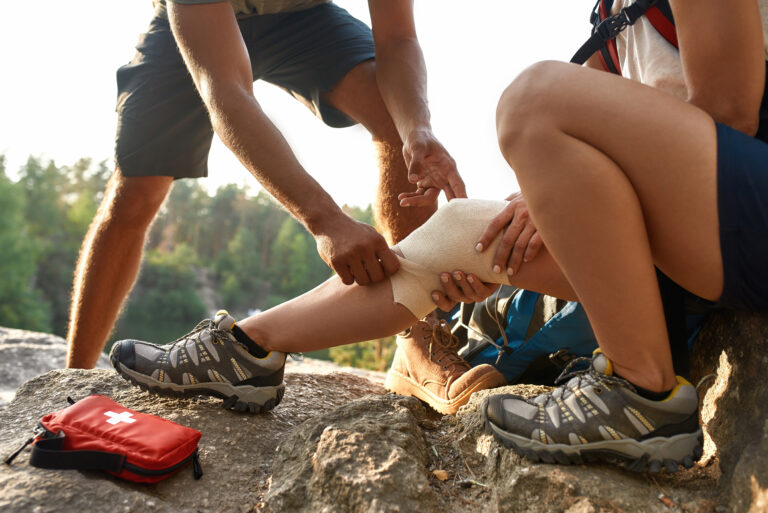Identifying the bite's culprit can help assess the first course of action. While you can treat some bites with an icepack and some rest, others need immediate medical care. If you’re unsure whether the bite or sting warrants medical attention, err on the side of caution and seek advice from a medical professional.
How to identify an insect bite
SafeWise experts have years of firsthand experience testing the products we recommend. Learn how we test and review.
Insect bites
If an insect has bitten you, you’ll notice a puncture wound in the skin. The area around the bite might be swollen, inflamed, and irritated, but rest assured these symptoms will likely clear up within two days. If you notice a wound, mark or bump that looks infected, consult your GP for the best course of treatment.
Mosquitoes
Like mini disease-transmitting vampires, mosquitos come alive during the nighttime to feast on your blood. If a mosquito has bitten you, you’ll notice a raised red or pink bump. Your skin might be swollen and itchy but fear not, it's easily treatable. Clean the stung area with soap and water, apply an ice pack, and take some paracetamol for the pain.
Bedbugs
To no surprise, bedbugs can make a home of your bed. You might also find them in your luggage after an overnight trip or in secondhand furniture. If you’ve been bitten by a bedbug (that’s a tongue twister), you’ll notice clustered red marks across your skin. Bedbugs excrete an anesthetic before biting, so if you are unfortunate enough to get bitten, you won’t feel it.
Over-the-counter steroid cream and an oral antihistamine can help relieve inflammation and itching. An ice pack wrapped in a towel and some paracetamol can also help relieve any swelling and pain.
Ticks
Ticks have a reputation for the pain they inflict on animals, but humans can also be on the receiving end. Ticks are tiny parasites that look like spiders, and there are over 70 species of them across Australia. Of these species, only 17 are known to attach and feed on humans.
Most tick bites are from a type of paralysis tick, also known as the grass tick, seed tick, or bush tick. As you can guess, they’re commonly found perched on long blades of grass and branches.
If you visit an area that’s known to contain ticks, make sure you check all children and pets for ticks and thoroughly wash your clothes afterwards. If you end up housing a tick for up to four days, you could fall victim to tick paralysis. If you’re experiencing headaches, lethargy, or facial paralysis, seek medical attention immediately.
Tick bites are usually harmless. If a tick bites you, you’ll notice a swollen, red bullseye around the bite. Most symptoms will subside once the tick is removed. Spray it with an ether-containing spray, then once you’re sure it's dead, pull it off with a pair of tweezers. Do not squeeze, agitate, or try to forcibly remove the tick, as this can cause it to inject more of its saliva into your bloodstream.

Ants
With any bite, it's important to know when to rush to the hospital. The severity of ant bites can range from a slight pinch to toaster-in-the-bathtub level pain. If any bite causes you to have trouble breathing or slip in and out of consciousness, seek immediate medical attention. If you’ve had a severe reaction to an ant bite in the past or you’re knowingly allergic to ant bites, immediately contact a medical professional.
Fire ants
If you get bitten by a fire ant, you’ll experience a burning or stinging sensation. Then you’ll develop some itchy bumps. After a few hours, the bumps might develop into itchy blisters. After a week or so your skin should be free from any pain or blisters. To help relieve pain and swelling, apply an ice pack then wash your skin with soap and water. To reduce the itchiness, take an antihistamine and apply hydrocortisone cream on the affected area.
Bull ants
Bull ants are the biggest ants in Australia. They’re mean, territorial, and a bite from them will likely need hospital care. While they love woodlands and heathlands, AIHW’s venomous bites and stings report says a third of reported stings happened in and around the home.
Bull ant bites are agonizing. Much like a fire ant bite, the pain you’ll experience from a bull ant feels like fire on your skin. The pain can last for hours, or even days after the initial bite. Your reaction to the bite will determine whether you need medical attention. If you experience symptoms that could indicate an allergic reaction (like trouble breathing or dizziness), head to the hospital.
Otherwise, treatment is simple. Wash the area with water and soap, and apply an ice pack to relieve the swelling. You can ease the fiery pain by taking paracetamol or ibuprofen. If you experience any persistent itching or swelling, take an antihistamine. If the bite won’t go away after three days or shows signs of infection, seek medical advice.
Spiders
Australia has a reputation for its menacing spiders. Even though there are over 2,000 species of spiders in Australia, only a handful are dangerous to humans. While all spiders have venom glands that can cause harm to humans, few have fangs that are sharp enough to puncture the skin and cause a reaction.
Funnel-web spider
This highly venomous spider is undoubtedly the deadliest arachnid in Australia. Commonly found in New South Wales, they love humid sheltered places and bushland. They are aggressive when frightened, so it's important not to provoke one if it comes across your path.
As soon as you’re bitten by a funnel-web spider, treat it as a medical emergency and call 000 immediately. While it might seem like overkill to call for an ambulance straight away, funnel web venom has killed children in as little as 15 minutes. The bite will cause nausea, numbness, and vomiting. Since the fangs on a funnel-web spider are larger than that of a brown snake, its bite will put you in a serious amount of pain.
While you’re waiting for the ambulance, mark the bite site with a pen or take a photo. If you’re certain you’ve been bitten by a funnel web, apply a pressure immobilisation bandage. This slows the movement of its venom in your blood.
Firmly wrap an elasticised bandage over the bitten area, then bandage the entire limb. If the spider has bitten your ankle, for example, wrap from your toes to your hip. Apply a rigid splint (like a piece of wood or a rolled-up piece of paper) and lie still while waiting for the ambulance to arrive.

Redback spider
Redback spiders love dry, sheltered places like sheds and mailboxes. A bite from a redback spider can cause redness, pain, and sweating at the bite site. Depending on the severity of your reaction, these symptoms can remain for days on end. While a bite from this spider is painful, you can treat it at home. Wash the bite area with soap and water then hold an ice pack to the site for 15 minutes. If your pain is unbearable, head to the nearest hospital.
Mouse spider
Mouse spiders hide in burrows and dwell near rivers or waterways. Mouse spiders are rarely aggressive, but their venom is as deadly as the funnel web. The symptoms of a mouse spider bite are like that of a funnel-web spider bite. If you suspect you may have been bitten by a mouse spider, treat it as you would a funnel web bite. Call 000 right away, then pressure bandage the affected area while you wait.
Bees and wasps
Wasps and bees will sting you if they feel threatened, especially if you’re near their nest. While most bee and wasp stings won’t require medical treatment, they still hurt!
The majority of people who get stung by a wasp or bee have minor symptoms that subside within a few hours. If you get stung, you’ll feel a sharp burning pain that develops into an itchy, red welt. If you look closely, you can see a tiny white mark in the middle of the welt where the stinger punctured the skin.
Bees will lose their stinger upon attacking you. If it remains in your skin, use a fingernail to carefully flick it out. Don't reach for the tweezers, as this can squeeze more venom into your skin.
Clean the sting site with soap and water, and apply an ice pack to reduce swelling and pain. If the itchiness won’t relent, oral antihistamines might help. If your symptoms won’t ease up after a few days, chat to your GP.
Preventing insect bites
Insects and arachnids have their ways of protecting themselves and their territory. Most will leave you alone if you do the same, but if you get too close, they might tell you to back off in the only way they know how.
If you’re passing through long grass, heathlands, or areas you know insects frequent, douse yourself in insect repellent and wear closed-toe boots.
It can protect your skin and save you a trip to the hospital if you get bitten. Avoid standing or squatting over the nests of insects, as they can become aggressive if you get too close. If you're a green thumb, always wear gloves when gardening and check your shoes before you put them on, especially if you keep them outside.
Final word
Most bites and stings are not deadly enough to warrant medical attention. If you’ve had a nasty reaction to a bite or sting before, or you’re allergic to a certain insect’s venom, keep an eye on your symptoms. If something feels off, seek immediate medical medical attention, and remember they’re more scared of you than you are of them!